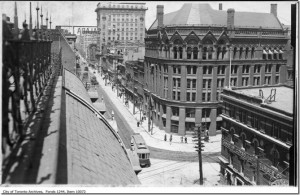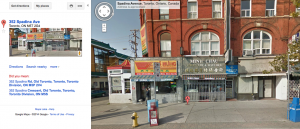The Chinese in Early 20th Century Toronto: 139 Queen St. W
Works sourced:
Works sourced:
The residential building was located on what is now Dundas St. W. at Dennison Rd. It was owned by Joseph O’Patterson from 1899 to 1901. This building was a wooden building that stayed wooden for more than twenty years according to fire insurance plans. During the time frame of 1899 to 1901 the building had different tenants. Spark Williams lived in this building with two adults from the end of the 19th century until 1900. In 1903, a new name shows up on the tax records: George Hutchington. Mr. Hutchington lived with three other people, none of them children. A factor that did stay the same was that all of the residents throughout the years observed were listed as Protestant. The building has since been torn down, and it is currently a vacant business place, but the upper floor is home to about twenty tenants, the majority of them being students. This building is two blocks away from the heart of Toronto’s Chinatown and is currently owned by a Chinese immigrant.
Works Cited
Assessment Roll: Ward 4 Division 2 1899. Toronto Archives.
Assessment Roll: Ward 4 Division 2 1900. Toronto Archives.
Assessment Roll: Ward 4 Division 2 1901. Toronto Archives.
Goads Fire Insurance Plan: Central Toronto (1899); Toronto Archives Website
Goads Fire Insurance Plan: Central Toronto (1924); Toronto Archives Website
In a July 1900 letter to Rev. Mackay noted in Valerie’s Mah’s Bachelor Society , 175 St. Patrick Street was an address associated with early Chinese immigrants to the city of Toronto. 175 St. Patrick Street was located at the intersection of what is now Dundas Street West and Kensington Road. In 1899, according to tax documents, eight people were residing in this brick residence, three of them children, suggesting it to be a residence for multiple people, possibly immigrants. It was owned by Robert Crates, but the main tenant was Robert McLelland. It is possible that some of the other residents may have been Chinese since the location was relatively close to where old Chinatown used to be. In 1901 the ownership of the building changed hands. Robert McLelland became not only the tenant but the taxable owner as well of the building. The number of residents did not change. This building has since been torn down and is now part of a public housing complex only a block away from the heart of Chinatown at Spadina St. and Dundas St. W.
Works Cited
Assessment Roll: Ward 4 Division 1 1899, Toronto Archives.
Assessment Roll: Ward 4 Division 1 1900, Toronto Archives.
Assessment Roll: Ward 4 Division 1 1901 Toronto Archives.
Goads Fire Insurance Plan: Central Toronto (1899); Toronto Archives Website
Goads Fire Insurance Plan: Central Toronto (1924); Toronto Archives Website

Our Lady of Mount Carmel Church (present)
202 St. Patrick Street in Toronto, Ontario is currently a community centre for those of Chinese heritage. The Toronto Chinese Catholic Centre is connected to a Chinese Roman Catholic Church entitled “Our Lady of Mount Carmel Church”. However, 202 St. Patrick Street was not always a community centre. Through the assistance of the City of Toronto Archives, I was able to conclude that the location was actually a Roman Catholic school in the early 1900s. In fact, the location was not even known as “202 St. Patrick Street”. Pre-1900s to 1920’s, the street St Patrick was called Williams Street and the lot number was 208. William Street intersected with Caer-Howell Street (now Elm Street) and Anderson Street (now Dundas St. West). The name of the school is referenced in the maps as “St. Patrick’s School”, however, in other records, the name is disclosed.
Even in the early 1900s, the school (along with other prominent establishments, like the “Planning Mill”) was one of the few brick-built structures in the area. Most houses near the school were wooden . The school and church were able to build an additional cathedral beside “Our Lady of Mount Carmel” by the year 1913, the reason is unknown. By 1913, the school was now considered as lot 202 but the street name was still Williams Street.
202 St. Patrick Street was classified as “separate school” in the 1901 Assessment Roles. This is important because it was not considered a public establishment, thus the taxation rate was paid differently. The owner name is indicated by 1914. “J. Hall” who lives at 28 Duke Street was considered the owner of the school at the time. As the 1922 Assessment Role indicates, “J. G. Hall” seems to keep the building through the 1920’s as well.
The size of the lot was 79×126 meters. This lot size remains unchanged from 1901 through 1922 showing a lack of additions made to school over the years. Another indication that the building was not added to is the “Value of the Building”. The “Value of the Building” remains at $4000 throughout the years 1901 through 1922. However, the “Value of Land” began to increase substantially. The land cost grew from $3160 in 1901 to $8690 in 1913.
The number of tenants is always listed as “X” indicating there is nobody who was living at 202 St. Patrick Street at any point of its establishment. Another (rather obvious) side note is that the school is labelled “Exempt” when mentioning livestock or crop production.


Wu Chong was a tenant at 956 Queen St. West, owned by James Hunter, and operated a laundry mat from that location. According to the Toronto Street Directories, the property was listed under Sells H & Sons, assumed to be Hunter & Sons, in 1889 and “Wer. Chong” became a tenant in 1890. The name “Wer. Chong” may be an interpretation of his name by the person filling out the assessment. According to the Assessment Roll of 1900 and Valerie Mah’s “The Bachelor Society”, there is only one person listed under this address, meaning that Wu Chong was either a bachelor or working and sending money home to his family in China. It can be confirmed that Chong operated from that establishment from 1890-1917. However, beginning in 1917, the establishment is listed in the Toronto Directory as “Chinese Laundry”, which may have still been operated by Chong. The property is located across from what was then known as the Provincial Lunatic Asylum (known today as the Centre of Addiction and Mental Health (CAMH)). The appearance of the shop can be assumed to be similar to the properties shown in the photo above of 990 Queen St West in June of 1919. The location is currently occupied by the Museum of Contemporary Canadian Art (MOCCA) and will be replaced by condominiums as part of a redevelopment plan.
Works Cited:
Assessment Roll (1900) Ward 5 Division 1; City of Toronto Archives.
Mah, Valerie. The bachelor society: a look at Toronto’s early Chinese community from 1878-1924. MA Thesis. 1978. Print.
Provincial Lunatic Asylum (June 1973). Public Works Photographs. Series 372, Item 69. City of Toronto Archives.
Toronto Directory (1889-1917); City of Toronto Archives.
990 Queen St W (June 17, 1919). Public Works Photographs. Series 372, Item 811. City of Toronto Archives.

352 Spadina Ave. in 2014 Google Maps
In accordance with Valerie Mah’s research, the City of Toronto Directories from 1900 and the Tax Assessment Rolls from 1901 do verify that, at that time, 352 Spadina Ave. was occupied by a person by the name of Mah Tang.
Valerie Mah’s research (in her thesis The Bachelor Society A Look at Toronto’s Early Chinese Community 1878-1924), which included a letter from Thomas Humprhies to Reverand MacKay, listed 95 Chinese establishments in Toronto on July 25 1900. That letter stated that 352 Spadina Ave. was occupied by Mah Tang and 3 other Chinese people.
The Tax Assessment records from 1901 state that Mah Tang was a tenant of Thomas Hook. His occupation is listed as “laundry.” Mah Tang’s business must have run out of the street-level portion of the building, because there is tax listing for another tenant that lived “over 352” named Patterson John J. (This upstairs tenant was recorded as 44 years old, with 6 family members, 3 children. The owner of the upstairs property was Edward Leadlay). Mah Tang was recorded to have 2 “Persons in Family” and no children.
According to Goads Fire Insurance Plans from 1903 (image attached), this building was located at the North-Western corner of the intersection of Spadina Ave. and St. Andrew St. In these plans, the building is coloured red, which indicates that it was a brick building.
Today that building bears the same address and is home to Minh Cau Jewellers who sell jewellery, watches and optical glasses (storefront image attached). Their website can be seen here: http://www.minhchau.ca/
___________________________
WORKS CITED
City of Toronto. Tax Assessment Rolls. Ward 4 Division 3 (1901). Reel 148, Location 264736:40. Microfilm. Pg. 50.
City of Toronto. Directories (1900). Reel 46. Microfilm. Pg. 233.
Mah, Valerie. The Bachelor Society: A Look at Toronto’s Early Chinese Community from 1878-1924. MA Thesis. 1978. Print.
Letter from Humprhies to Rev. MacKay, July 25, 1900, File 33, Box 1, United Church Archives, as noted in Mah 19.
According to Goads Fire Insurance Plans from 1903 (above), this building was located at the South-Western corner of the intersection of Spadina Ave. and College St. In these plans, the building is coloured red, which indicates that it was, indeed, a brick building. The photo (above) shows what the intersection looked like during the late 1920’s.
Today that building bears the same address and is home to The 460 Bistro Bar. The woman who runs the business is named Mona and she moved from Southern China under a decade ago. Her bar has become somewhat of a legend among Toronto’s underground art and music scene.
The 460’s website can be seen here: https://www.facebook.com/pages/The-460/103511123019232
Mona recalls that the previous business owner of 460 Spadina was a Vietnamese man named John. The City of Toronto Directories for 2001 do in fact list “John’s Restaurant” at that address.
Mona also recalls that before John, two Chinese women named Nancy and Michelle ran a restaurant and bar that served breakfast, lunch and dinner – apparently it was quite popular among University of Toronto students. The City of Toronto Directories for 1980 and 1990 simply list “Coffee Shop.”
_____________________________
CITATIONS
City of Toronto. Tax Assessment Rolls. St. Patrick’s Ward (1888). Microfilm. Pg. 81.
City of Toronto. Directories (1887). Microfilm. Pg. 213-214.
City of Toronto. Directories (1888). Microfilm. Pg. 248.
City of Toronto. Directories (1955). Microfilm.
City of Toronto. Directories (1980). Microfilm. Pg. 783.
City of Toronto. Directories (1990). Microfilm. Pg. 445.
City of Toronto. Directories (2001). Microfilm.